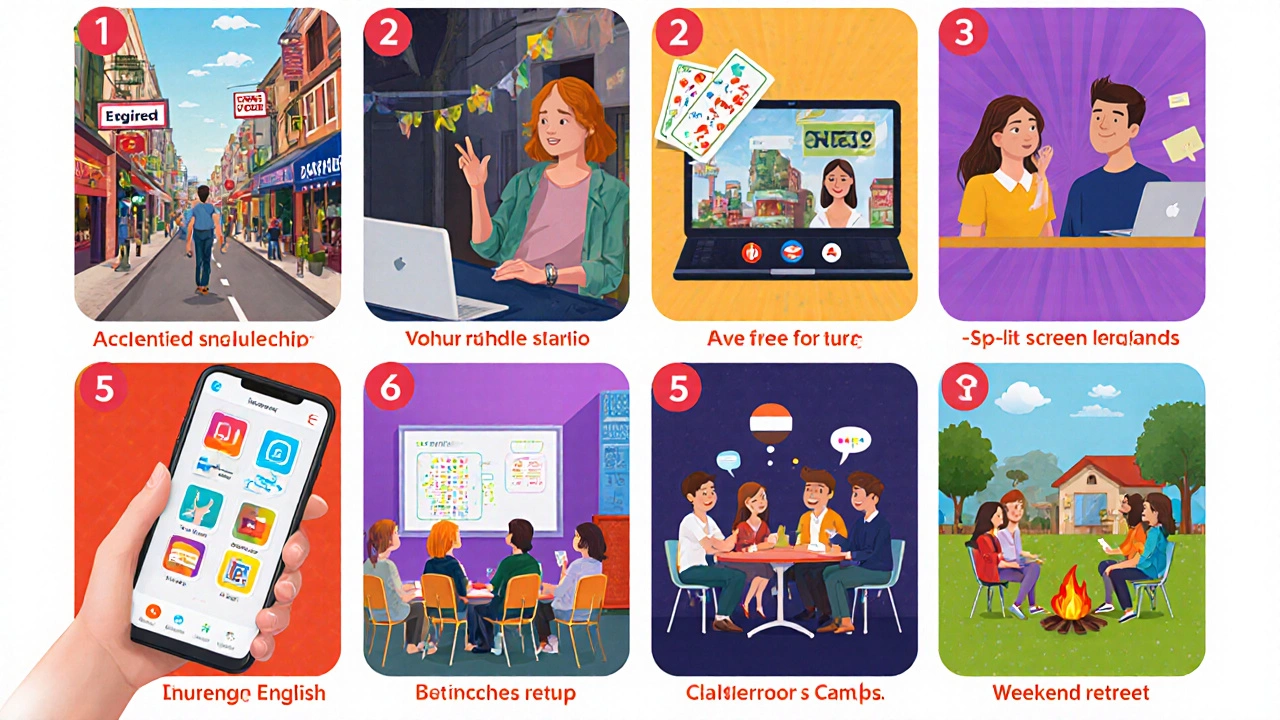English Learning Path Advisor
Find the best English learning method for your goals, budget, and time availability. Based on research showing the fastest paths to fluency.
Your Recommended Path
Recommended Methods
Expected Timeline
Action Plan
When it comes to English language learning is the process of acquiring speaking, listening, reading, and writing skills in English, speed matters. If you want to learn English fast, you need a plan that blends the right methods, tools, and habits.
Why Speed Can Be Tricky
Language acquisition isn’t a sprint; it’s a marathon with bursts of sprinting. Cognitive research shows that while adults can pick up new vocab quickly, true fluency requires repeated exposure and active use. The fastest paths work because they force constant input, immediate output, and feedback loops.
Top Accelerated Methods
Below are the six most effective ways to cut months off a typical learning timeline. Each method is explained with real‑world data and a brief microdata markup for easy reference.
Immersion
Immersion is living in an environment where English is the primary language, forcing daily use. Studies from the University of Toronto (2023) show learners in immersion programs reach B2 level in half the time of classroom‑only students.
Online English Course
Online English course is a structured, instructor‑led program delivered via video lessons, quizzes, and peer interaction. Platforms like Coursera and EdX report average course completion in 8 weeks with a 30% improvement in speaking confidence.
Language Exchange
Language exchange is a reciprocal conversation practice where two speakers teach each other their native languages. Apps such as Tandem record a 4‑hour weekly exchange translating into a 1‑level jump on the CEFR scale every two months.
Mobile Language App
Mobile language app is a smartphone‑based tool that uses gamified lessons, spaced repetition, and speech recognition. Duolingo’s 2024 internal data shows learners who practice 15 minutes daily achieve conversational ability in 3 months.
Intensive Bootcamp
Intensive bootcamp is a short‑term, high‑frequency program (often 4‑6 hours per day) focusing on speaking and listening. A 2022 IELTS prep bootcamp in Sydney delivered an average 1.5‑band score increase after just 4 weeks.
Spaced Repetition for Vocabulary
Spaced repetition is a memorization technique that schedules review sessions at increasing intervals. An experiment at the University of Melbourne demonstrated a 70% retention rate after 6 weeks versus 40% with cramming.
How to Combine Methods for Maximum Speed
- Week 1‑2: Start a mobile language app for 15 minutes daily to build core vocab.
- Week 3‑4: Enroll in an online English course that includes live speaking sessions.
- Week 5‑6: Pair up on a language exchange partner for 2‑hour weekly calls.
- Week 7‑8: Add pronunciation practice using shadowing techniques from podcasts.
- Week 9‑12: If possible, attend a short immersion weekend or a local intensive bootcamp.
This layered approach keeps motivation high while reinforcing each skill area.

Comparison of Fast‑Track Methods
| Method | Typical Time to B2 | Cost (USD) | Flexibility | Best For |
|---|---|---|---|---|
| Immersion | 3‑4 months | 200‑1500 (travel & stay) | Low (requires relocation) | Adult learners with funds |
| Online English course | 4‑6 months | 50‑300 | High (anytime, anywhere) | Structured learners |
| Language exchange | 5‑7 months | Free‑20 | High (schedule calls) | Social learners |
| Mobile app | 6‑8 months | 0‑30 (free‑premium) | Very high | Busy professionals |
| Intensive bootcamp | 1‑2 months | 400‑1200 | Medium (fixed schedule) | Exam‑focused students |
Common Pitfalls and How to Avoid Them
- Relying on a single method. Diversify to cover listening, speaking, reading, and writing.
- Skipping feedback. Use speech‑recognition tools or native speakers to correct errors early.
- Inconsistent practice. Set a minimum of 30 minutes daily; short bursts beat occasional long sessions.
- Focusing only on grammar. Real‑life conversation builds confidence faster than rule memorization.
- Neglecting pronunciation. Shadow native podcasts and record yourself daily.
Action‑Plan Checklist
- Pick a mobile language app and commit to daily 15‑minute sessions.
- Enroll in an online English course that offers live speaking labs.
- Find a reliable language exchange partner on platforms like Tandem.
- Schedule weekly pronunciation practice using the shadowing method.
- If budget allows, book a 3‑day immersion weekend or a local intensive bootcamp.
- Track progress with a CEFR self‑assessment every month.
Frequently Asked Questions
How long does it really take to become conversational?
With consistent daily practice (30‑45 minutes) and a mix of immersion, app work, and conversation, most adults reach an A2‑B1 level in 3‑4 months.
Is it better to study grammar first or start speaking?
Start speaking early. Basic grammar can be learned on‑the‑fly; waiting for perfect rules delays fluency.
Can I learn English fast without spending money?
Yes. Free mobile apps, YouTube channels, and language‑exchange partners can cover most essentials. The trade‑off is slower progress compared to paid intensive programs.
What role does media consumption play?
Watching shows with subtitles builds listening comprehension and natural phraseology. Aim for 1‑hour of English media daily.
How often should I review vocabulary?
Use spaced‑repetition software (e.g., Anki) and review new words after 1 day, 3 days, 1 week, and 2 weeks to cement long‑term memory.

